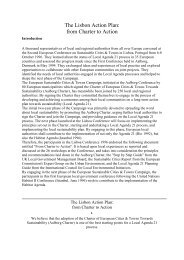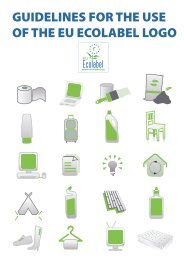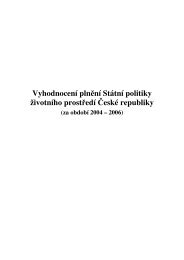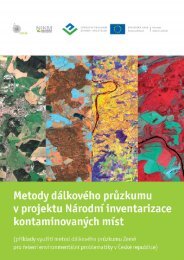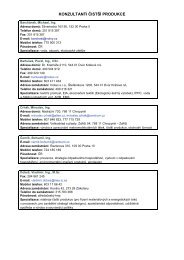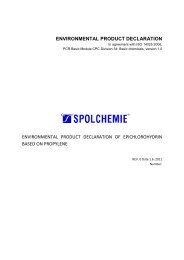Environmental Technologies and Eco-innovation in the Czech ...
Environmental Technologies and Eco-innovation in the Czech ...
Environmental Technologies and Eco-innovation in the Czech ...
You also want an ePaper? Increase the reach of your titles
YUMPU automatically turns print PDFs into web optimized ePapers that Google loves.
pressure, it complies with <strong>the</strong> strictest requirements for many liquid filtration<br />
facilities. Nano-fibres may <strong>the</strong>refore help to resolve <strong>the</strong> global lack of dr<strong>in</strong>k<strong>in</strong>g water,<br />
may help to make sea water desal<strong>in</strong>isation easier <strong>and</strong> more efficient.<br />
Fur<strong>the</strong>rmore, nano-fibres may be used <strong>in</strong> produc<strong>in</strong>g energy from renewable<br />
resources. Nano-fibres can replace both classical silica cells <strong>and</strong> <strong>the</strong> new generation<br />
of cells with nano-composites 10 . They also enable operation <strong>in</strong> aggravated light<br />
conditions (no sunsh<strong>in</strong>e) <strong>and</strong> <strong>the</strong> use of mobile power sources (<strong>the</strong> comb<strong>in</strong>ation of<br />
solar cells with batteries for nano-fibres).<br />
5.3 | Absorption materials based on natural m<strong>in</strong>erals<br />
Natural materials that may be used as absorbents for water contam<strong>in</strong>ants or waste<br />
gases <strong>in</strong>clude m<strong>in</strong>erals such as montmorillonite, bentonite, kaol<strong>in</strong>ite, halloysite,<br />
etc. However, natural m<strong>in</strong>erals are hydrophilic 11 <strong>and</strong> are unsuitable for absorb<strong>in</strong>g<br />
organic pollutants. They feature layered structures with a layer thickness of ca 1 nm.<br />
The space between <strong>in</strong>dividual layers, <strong>the</strong> <strong>in</strong>terlayer, is filled with <strong>in</strong>organic cations<br />
which compensate for <strong>the</strong> negative charge <strong>in</strong> <strong>in</strong>ner layers of a m<strong>in</strong>eral. Replac<strong>in</strong>g<br />
<strong>in</strong>organic cations <strong>in</strong> <strong>in</strong>terlayers by organic cations causes changes to <strong>the</strong> m<strong>in</strong>eral’s<br />
properties <strong>and</strong> <strong>the</strong>refore becomes organophilic 12 <strong>and</strong> enables <strong>the</strong> absorption of<br />
organic pollutants. The properties of absorbents are given by organic cations used.<br />
For clay m<strong>in</strong>erals, m<strong>in</strong>erals based on smectites are <strong>the</strong> most frequently used for <strong>the</strong>se<br />
modifications to environmental technologies. For waste water treatment technologies,<br />
organically modified clays may be used separately as absorption materials for treat<strong>in</strong>g<br />
waste water contam<strong>in</strong>ated by organic compounds, e.g. crude oil hydrocarbons, or <strong>in</strong><br />
comb<strong>in</strong>ation with active coal. They can form a part of <strong>the</strong> clay barriers <strong>and</strong> absorbents<br />
of organic substances <strong>in</strong> dumps.<br />
Ano<strong>the</strong>r suitable natural material seems to be vermiculite, whose use is currently<br />
be<strong>in</strong>g analysed at <strong>the</strong> University of M<strong>in</strong><strong>in</strong>g – <strong>the</strong> Technical University of Ostrava. The<br />
research is ma<strong>in</strong>ly aimed at prepar<strong>in</strong>g <strong>and</strong> test<strong>in</strong>g organically modified vermiculite for<br />
absorption of organic substances from waste water <strong>and</strong> gases. Organically modified clay<br />
has been made from vermiculite m<strong>in</strong>ed <strong>in</strong> <strong>the</strong> <strong>Czech</strong> deposit of Letovice <strong>and</strong> efficiently<br />
absorbs organic substances found <strong>in</strong> waste water.<br />
10 nano-composites – materials consist<strong>in</strong>g of two or more different components where one of <strong>the</strong>m is up to tens of nanometers;<br />
<strong>the</strong>se are mostly nano-particles of active substances<br />
11 hydrophilic – able to absorb water or be diluted <strong>in</strong> water<br />
12 organophilic – able to bound organic substances or dilute <strong>in</strong> organic solvents




